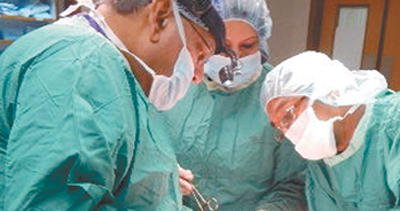Three local doctors have made medical history.
The trio — urologist and lead surgeon Dr Lall R Sawh, general vascular surgeon Dr Steve Budhooram and Dr Peng Ewe, anesthetist and intensivist — removed an eight-pound tumour from a 52-year-old man at the Southern Medical Clinic, San Fernando, last week Wednesday.
According to medical records, this is the largest tumour removed in the western hemisphere and the second largest ever in the world.
Medical records which the doctors used to base their feat, show that the largest tumor successfully removed from a patient weighed 5.018 kilos (approximately 11 pounds) and was done during a five-and-a-half-hour surgery at the All India Institute of Medical Sciences in New Delhi, India, breaking the previous record of a 5.5-pound tumour removed at Sir Gangaram Hospital, also in India.
The operating time for the local surgery was two hours whilst theatre time was three hours, allowing one hour for anesthetic preparation and monitoring by Ewe prior to the knife to skin start time.
The three doctors sat down for an interview with members of the media at Sawh’s medical office yesterday and described the surgery as “touch and go” because of a number of pre-existing medical conditions the patient, whom they did not name, had.
Among them were cardiac issues and scoliosis, which caused the bending of his spine. All together, they said, that left limited space for the doctors to work to remove the tumour successfully.
Sawh equated the eight-pound growth to that of the size of a woman’s stomach when she is some months pregnant.
He said the growth may have developed over a year but the patient’s “self-diagnosed” used a regimen of herbal medicine to cure his sudden weight loss and extending stomach. He said strangely, the patient said he had no pain nor did he pass blood in his urine as is usual with a tumour.
“It is amazing somebody could actually carry that around for a year and not see something is wrong. I am loosing weight, not feeling my usual self, in this day and age people still take things for granted,” Sawh said.
Only a few weeks ago, when the patient started experiencing severe abdominal pain, he sought Sawh’s services. Sawh said from the moment he saw him he knew if the growth was not removed from the patient’s left kidney he would have died.
“When we saw his scans, we realised we had big challenges and for the first time in my 35-year medical career, I made a man sign a consent form that he could die on the operating table,” Sawh said.
Budhooram added; “The tumour was so huge it was pushing the diaphragm, the left lung and the heart up. The growth was also going down into his pelvis, so this thing occupied the entire left half of the abdomen and even pushed his major blood vessels, which are normally in the middle, to the right.”
He said the vein of the tumour was actually larger than the vein going to the heart, which posed another challenge.
Sawh interjected: “So the challenge was space and as Dr Budhooram explained, if you make one error with the blood vessels that is death on the operating table.”
Anaesthetist Ewe said he too faced a number of challenges to put the patient to sleep because the patient had a large mass compressing on the heart and a pre-existing cardiac issue.
“So we had to get the cardiologist to come in and see him and do and ECHO so I could assess and anticipate what problems I would face with him.
“Also, with the big mass pressing against the diaphragm, squashing the base of the lungs, you had to adjust how you ventilate him because the lungs would not have much room for expansion after that big mass comes up.
“So to put him to sleep, we obviously had to do a lot of invasive monitoring. We had to put in a lot of lines to monitor the blood pressure and the fluid status. Because of the pre-existing heart condition we couldn’t overload him with liquid because his heart would not have been able to take the strain,” Ewe added.
The doctors said they had to wait for the right time to operate as a result of those existing conditions.
Nevertheless, on December 2, after Ewe was able to prepare and put him to sleep, Sawh and Budhooram, ably supported by scrub nurse and head operating theatre nurse, Susan Maharaj, and her team of Moncy Mathew and the theatre staff, went to work on the patient from east Trinidad for three hours to undertake one of the riskiest challenges of their careers.
“We did him on Wednesday, he was kept in the Intensive Care Unit (ICU) for the first 24 hours and by Saturday, he was home, three days post-operatively,” Sawh said.
The removed tumour specimen was weighed and sent to the labs for analysis.
In terms of his survival, Sawh said they have to wait for the histology from the labs and if all his organs were fine then that would be a sign he was cured. However, if the capsule has been breached then he may have to do additional chemotherapy.
The doctors said the case would be published in an international medical journal. Yvonne Webb (Trinidad Guardian)














